Numerical Modeling of Droplet Aerosol Coagulation, Condensation/Evaporation and Deposition Processes
Abstract
:1. Introduction
2. Materials and Methods
2.1. Description of the Droplet Aerosol Dynamics
2.2. Implementation of the DWOSMC Algorithm
- (1)
- Start with a predetermined total MC loop number, M.
- (2)
- Predetermine the simulation stopping time, Tstop.
- (3)
- Initialize the particle system. The weight, component, and size distribution of the droplet aerosols are initialized first. The weight of numerical particle i, wi is defined aswhere Nr(υX, υY) is the real particle number of particles with volume (υX, υY) and Nn(υX, υY) is the numerical particle number that representing the corresponding real particles.
- (4)
- Determine a time step τ for the simulation.
- (5)
- Algorithm integration. In this DWOSMC method, the coagulation event is simulated by the stochastic Monte Carlo method; and the deposition and condensation/evaporation events are calculated by the deterministic method. Then, the simulation results are integrated by the operator splitting method expressed by Equation (9) [35], which means that in one time step, the deposition and condensation/evaporation events will be firstly calculated within the first half time step. Then, the coagulation event will be calculated, at last, the deposition and the condensation/evaporation events will be calculated within the second half time step.where ψ represents the total particle dynamical processes, ψd represents the deposition event, ψc represents the condensation/evaporation event, and ψs represents the coagulation event.
- (a)
- Coagulation
- (b)
- Deposition
- (c)
- Condensation and evaporation
- (6)
- The properties of the numerical particles (component composition, size distribution, weight, etc.) are updated.
- (7)
- If the present simulation time, T, reaches Tstop, stop the present MC loop. Otherwise, repeat step (4) to step (6).
- (8)
- If the current MC loop number N equals M, the mean value of the particle parameters should be calculated and output. Otherwise, start a new MC loop.
3. Results
3.1. Coagulation and Condensation/Evaporation Processes in Single Component Aerosol Systems
3.2. Coagulation, Deposition, and Condensation/Evaporation Processes in Single Component Aerosol Systems
3.3. Coagulation, Deposition and Condensation/Evaporation Processes in Two-Component Aerosol Systems
4. Conclusions
Author Contributions
Funding
Institutional Review Board Statement
Informed Consent Statement
Data Availability Statement
Conflicts of Interest
References
- Wu, J.T.; Leung, K.; Leung, G.M. Nowcasting and forecasting the potential domestic and international spread of the 2019-nCoV outbreak originating in Wuhan, China: A modelling study. Lancet 2020, 395, 689–697. [Google Scholar] [CrossRef] [Green Version]
- Prather, K.A.; Wang, C.C.; Schooley, R.T. Reducing transmission of SARS-CoV-2: Masks and testing are necessary to combat asymptomatic spread in aerosols and droplets. Science 2020, 368, 1422–1424. [Google Scholar] [CrossRef] [PubMed]
- Stiti, M.; Castanet, G.; Corber, A.; Alden, M.; Berrocal, E. Transition from saliva droplets to solid aerosols in the context of COVID-19 spreading. Environ. Res. 2022, 204, 112072. [Google Scholar] [CrossRef]
- Xu, X.; Zhang, J.; Zhu, L.; Huang, Q. Transmission of SARS-CoV-2 indoor and outdoor environments. Atmosphere 2021, 12, 1640. [Google Scholar] [CrossRef]
- Dao, H.T.; Kim, K.-S. Behavior of cough droplets emitted from Covid-19 patient in hospital isolation room with different ventilation configurations. Build. Environ. 2022, 209, 108649. [Google Scholar] [CrossRef]
- Bui, V.K.H.; Moon, J.Y.; Chae, M.; Park, D.; Lee, Y.C. Prediction of aerosol deposition in the human respiratory tract via computational models: A review with recent updates. Atmosphere 2020, 11, 137. [Google Scholar] [CrossRef] [Green Version]
- Kumar, J.; Peglow, M.; Warnecke, G.; Heinrich, S. An efficient numerical technique for solving population balance equation involving aggregation, breakage, growth and nucleation. Powder Technol. 2008, 182, 81–104. [Google Scholar] [CrossRef]
- Xie, M.; Yu, M. Thermodynamic analysis of Brownian coagulation based on moment method. Int. J. Heat Mass Transf. 2018, 122, 922–928. [Google Scholar] [CrossRef]
- Asgari, M.; Lucci, F.; Kuczaj, A.K. Multispecies aerosol evolution and deposition in a bent pipe. J. Aerosol Sci. 2019, 129, 53–70. [Google Scholar] [CrossRef]
- Shadloo-Jahromi, A.; Bavi, O.; Hossein Heydari, M.; Kharati-Koopaee, M.; Avazzadeh, Z. Dynamics of respiratory droplets carrying SARS-CoV-2 virus in closed atmosphere. Results Phys. 2020, 19, 103482. [Google Scholar] [CrossRef]
- Wells, W.F. On air-borne infection: Study II. Droplets and droplet nuclei. Am. J. Epidemiol. 1934, 20, 611–618. [Google Scholar] [CrossRef]
- Zhang, C.; Wang, Y.; Wang, H. Interaction between water and acetic acid-sodium halide aerosol: A molecular dynamics study. Powder Technol. 2017, 314, 9–19. [Google Scholar] [CrossRef]
- Lieber, C.; Melekidis, S.; Koch, R.; Bauer, H.J. Insights into the evaporation characteristics of saliva droplets and aerosols: Levitation experiments and numerical modeling. J. Aerosol Sci. 2021, 154, 105760. [Google Scholar] [CrossRef] [PubMed]
- Wong, L.T.; Chan, W.Y.; Mui, K.W.; Lai, A.C.K. An experimental and numerical study on deposition of bioaerosols in a scaled chamber. Aerosol Sci. Technol. 2010, 44, 117–128. [Google Scholar] [CrossRef] [Green Version]
- McGraw, R. Description of aerosol dynamics by the quadrature method of moments. Aerosol Sci. Technol. 1997, 27, 255–265. [Google Scholar] [CrossRef]
- Liu, S.Y.; Chan, T.L.; Liu, H.J. Numerical simulation of particle formation and evolution in a vehicle exhaust plume using the bimodal Taylor expansion method of moments. Particuology 2019, 43, 46–55. [Google Scholar] [CrossRef]
- Kochenburger, T.M.; Fernández, F.J.; Prieto, M.M. Study and modification of a size-discrete semi-implicit simulation model for polydisperse aerosol coagulation. J. Aerosol Sci. 2017, 114, 180–194. [Google Scholar] [CrossRef]
- Maisels, A.; Kruis, F.E.; Fissan, H. Direct simulation Monte Carlo for simultaneous nucleation, coagulation, and surface growth in dispersed systems. Chem. Eng. Sci. 2004, 59, 2231–2239. [Google Scholar] [CrossRef]
- Kotalczyk, G.; Kruis, F.E. A Monte Carlo method for the simulation of coagulation and nucleation based on weighted particles and the concepts of stochastic resolution and merging. J. Comput. Phys. 2017, 340, 276–296. [Google Scholar] [CrossRef]
- Chen, Z.; Lin, J.; Yu, M. Direct expansion method of moments for nanoparticle Brownian coagulation in the entire size regime. J. Aerosol Sci. 2014, 67, 28–37. [Google Scholar] [CrossRef]
- Kotalczyk, G.; Kruis, F.E. Fractional Monte Carlo time steps for the simulation of coagulation for parallelized flowsheet simulations. Chem. Eng. Res. Des. 2018, 136, 71–82. [Google Scholar] [CrossRef]
- Wei, J. A fast monte carlo method based on an acceptance-rejection scheme for particle coagulation. Aerosol Air Qual. Res. 2013, 13, 1273–1281. [Google Scholar] [CrossRef] [Green Version]
- Liu, H.M.; Chan, T.L. Two-component aerosol dynamic simulation using differentially weighted operator splitting Monte Carlo method. Appl. Math. Model. 2018, 62, 237–253. [Google Scholar] [CrossRef]
- Liu, H.; Chan, T.L. A coupled LES-Monte Carlo method for simulating aerosol dynamics in a turbulent planar jet. Int. J. Numer. Methods Heat Fluid Flow 2020, 30, 855–881. [Google Scholar] [CrossRef]
- Zhao, H.; Kruis, F.E.; Zheng, C. Reducing statistical noise and extending the size spectrum by applying weighted simulation particles in monte carlo simulation of coagulation. Aerosol Sci. Technol. 2009, 43, 781–793. [Google Scholar] [CrossRef]
- Zhou, K.; Jiang, X.; Chan, T.L. Error analysis in stochastic solutions of population balance equations. Appl. Math. Model. 2020, 80, 531–552. [Google Scholar] [CrossRef]
- Zhao, H.; Kruis, F.E.; Zheng, C. A differentially weighted Monte Carlo method for two-component coagulation. J. Comput. Phys. 2010, 229, 6931–6945. [Google Scholar] [CrossRef]
- Zhao, H.; Zheng, C. Monte Carlo solution of wet removal of aerosols by precipitation. Atmos. Environ. 2006, 40, 1510–1525. [Google Scholar] [CrossRef]
- Zhao, H.; Zheng, C. A new event-driven constant-volume method for solution of the time evolution of particle size distribution. J. Comput. Phys. 2009, 228, 1412–1428. [Google Scholar] [CrossRef]
- Liu, H.; Jiang, W.; Liu, W.; Liu, X.; Liu, S. Monte Carlo simulation of polydisperse particle deposition and coagulation dynamics in enclosed chambers. Vacuum 2021, 184, 109952. [Google Scholar] [CrossRef]
- Liu, H.; Chan, T.L. Differentially weighted operator splitting Monte Carlo method for simulating complex aerosol dynamic processes. Particuology 2018, 36, 114–126. [Google Scholar] [CrossRef]
- Kourti, N.; Schatz, A. Solution of the general dynamic equation (GDE) for multicomponent aerosols. J. Aerosol Sci. 1998, 29, 41–55. [Google Scholar] [CrossRef]
- Liu, H. Monte Carlo Simulation of Aerosol Dynamics in Turbulent Flows. Ph.D. Thesis, The Hong Kong Polytechnic University, Hong Kong, China, 2019. [Google Scholar]
- Xu, Z.; Zhao, H.; Zheng, C. Fast Monte Carlo simulation for particle coagulation in population balance. J. Aerosol Sci. 2014, 74, 11–25. [Google Scholar] [CrossRef]
- McLachlan, R.I.; Quispel, G.R.W. Splitting methods. Acta Numer. 2002, 11, 341–434. [Google Scholar] [CrossRef]
- Zhao, H.; Zheng, C. Two-component brownian coagulation: Monte carlo simulation and process characterization. Particuology 2011, 9, 414–423. [Google Scholar] [CrossRef]
- Liffman, K. A direct simulation Monte-Carlo method for cluster coagulation. J. Comput. Phys. 1992, 100, 116–127. [Google Scholar] [CrossRef]
- Prakash, A.; Bapat, A.P.; Zachariah, M.R. A Simple Numerical Algorithm and Software for Solution of Nucleation, Surface Growth, and Coagulation Problems. Aerosol Sci. Technol. 2003, 37, 892–898. [Google Scholar] [CrossRef]
- Ramabhadran, T.E.; Peterson, T.W.; Seinfeld, J.H. Dynamics of aerosol coagulation and condensation. AIChE J. 1976, 22, 840–851. [Google Scholar] [CrossRef]
- Palaniswaamy, G.; Loyalka, S.K. Direct simulation, Monte Carlo, aerosol dynamics: Coagulation and condensation. Ann. Nucl. Energy 2008, 35, 485–494. [Google Scholar] [CrossRef]

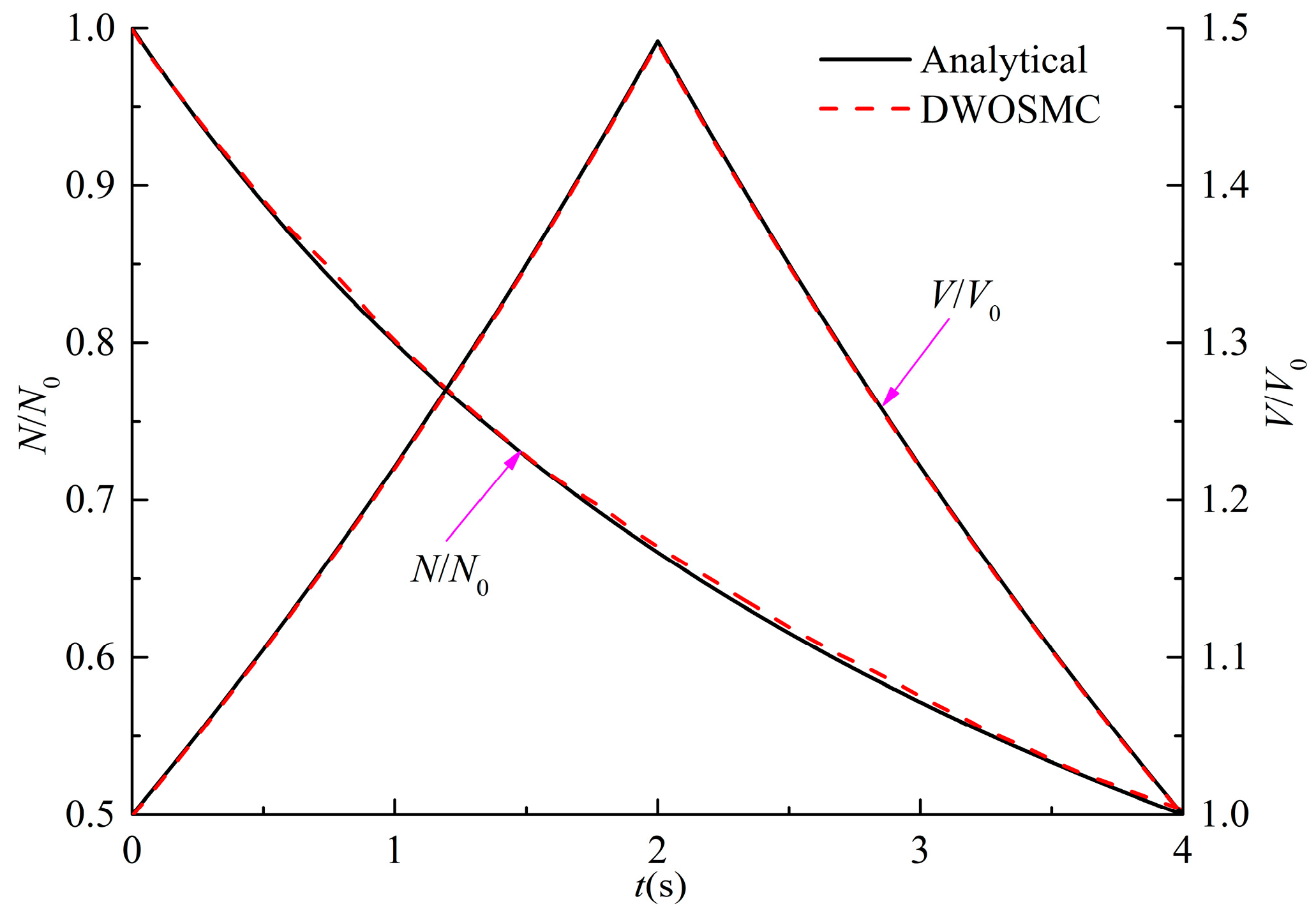
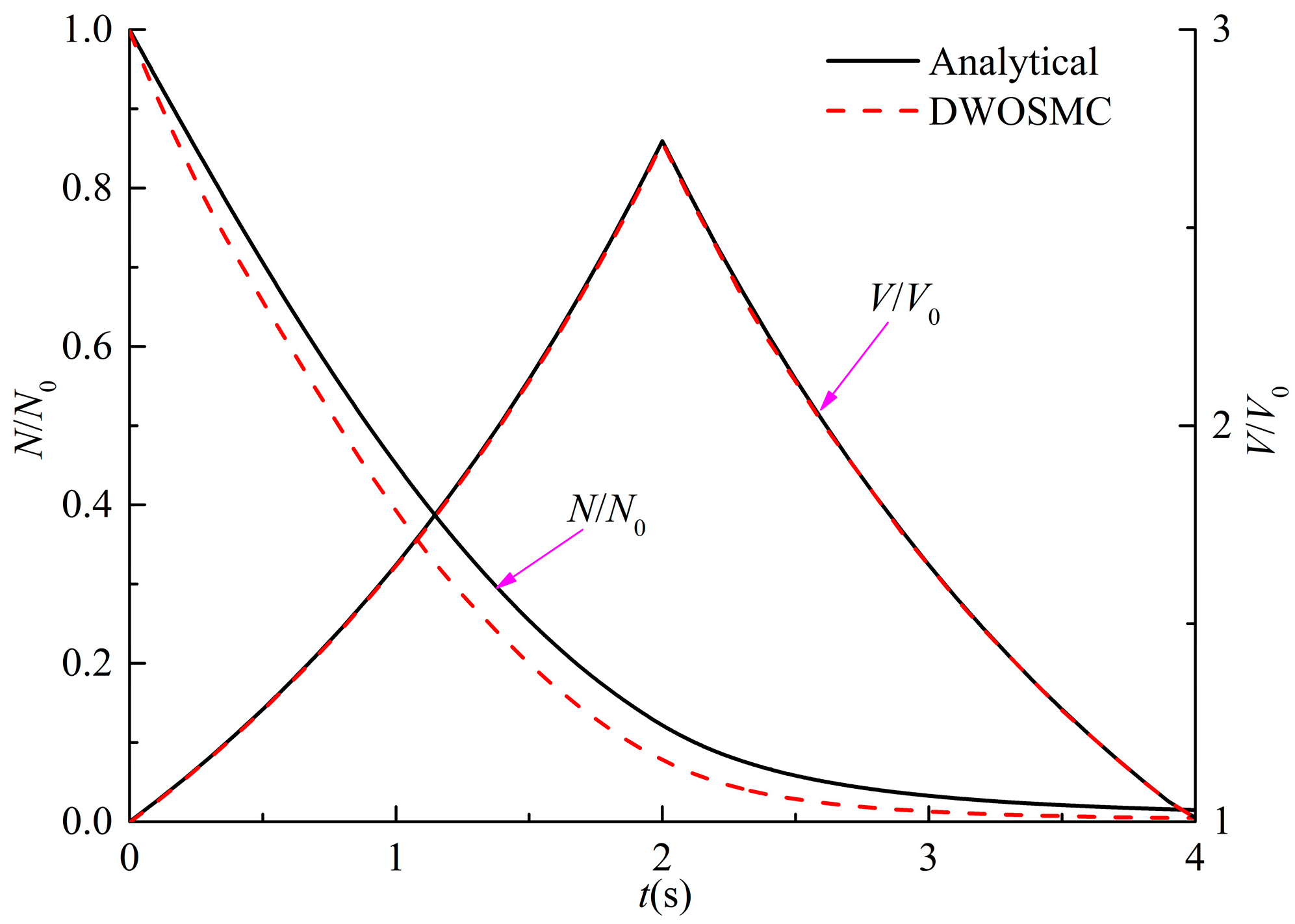




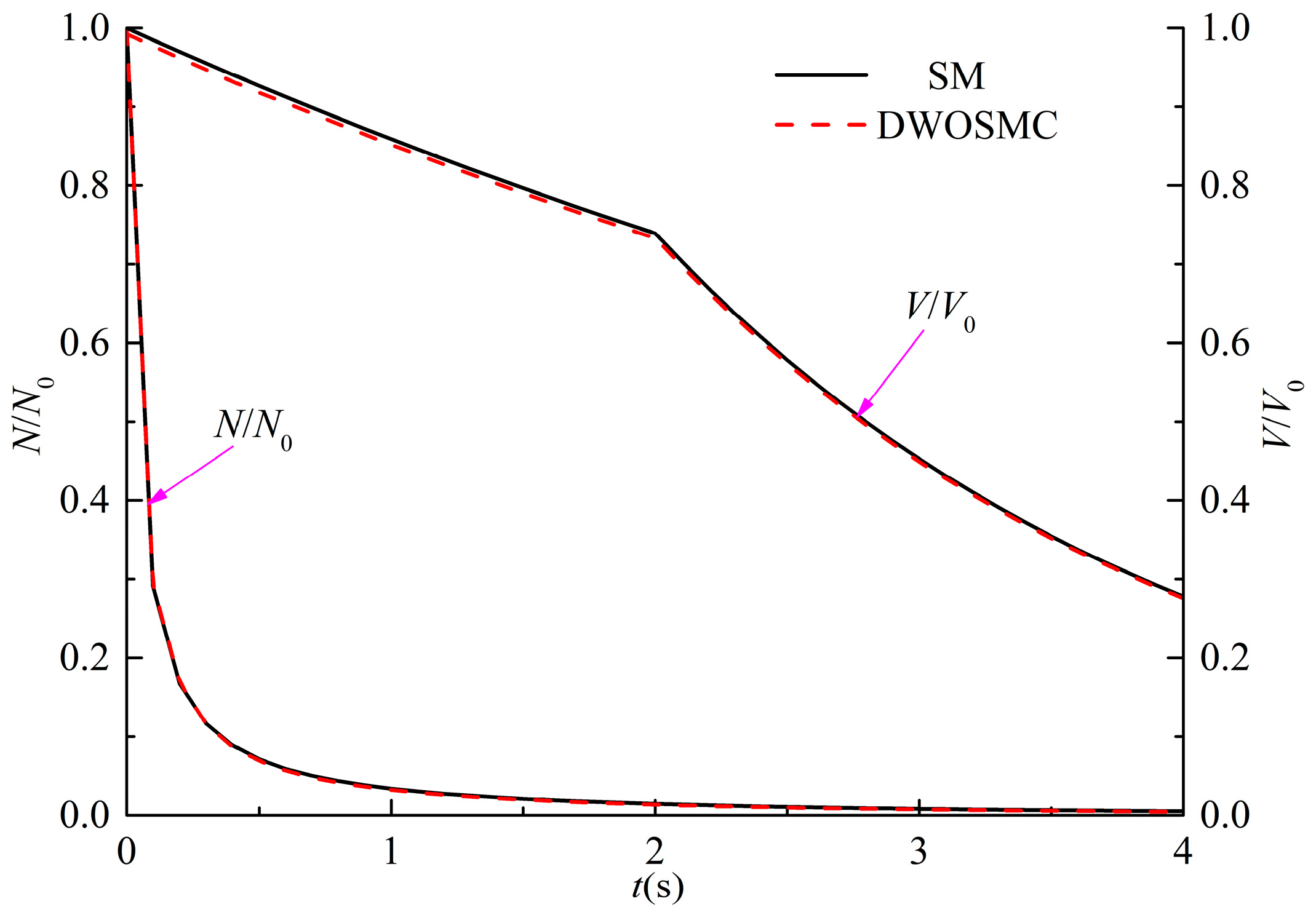
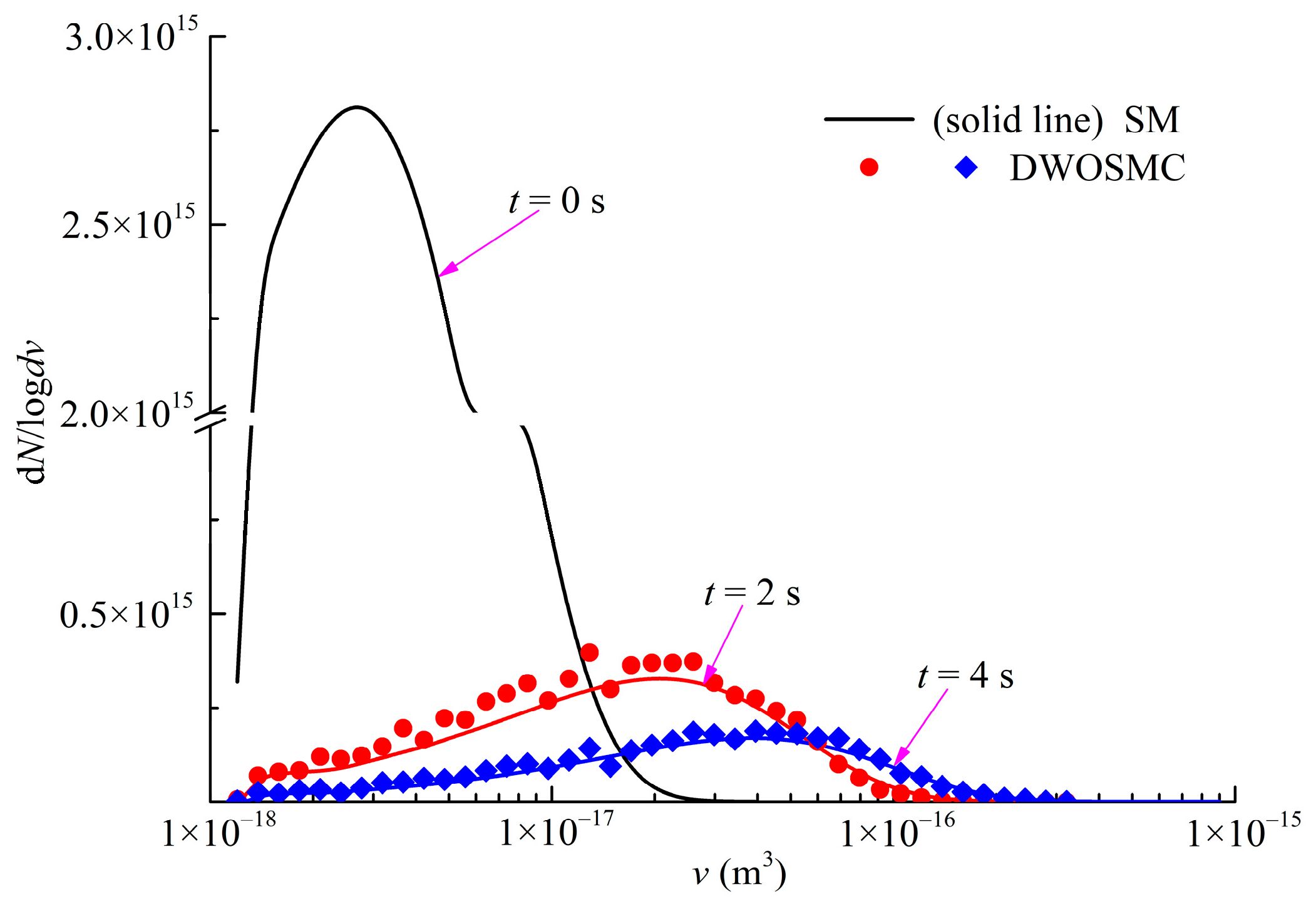

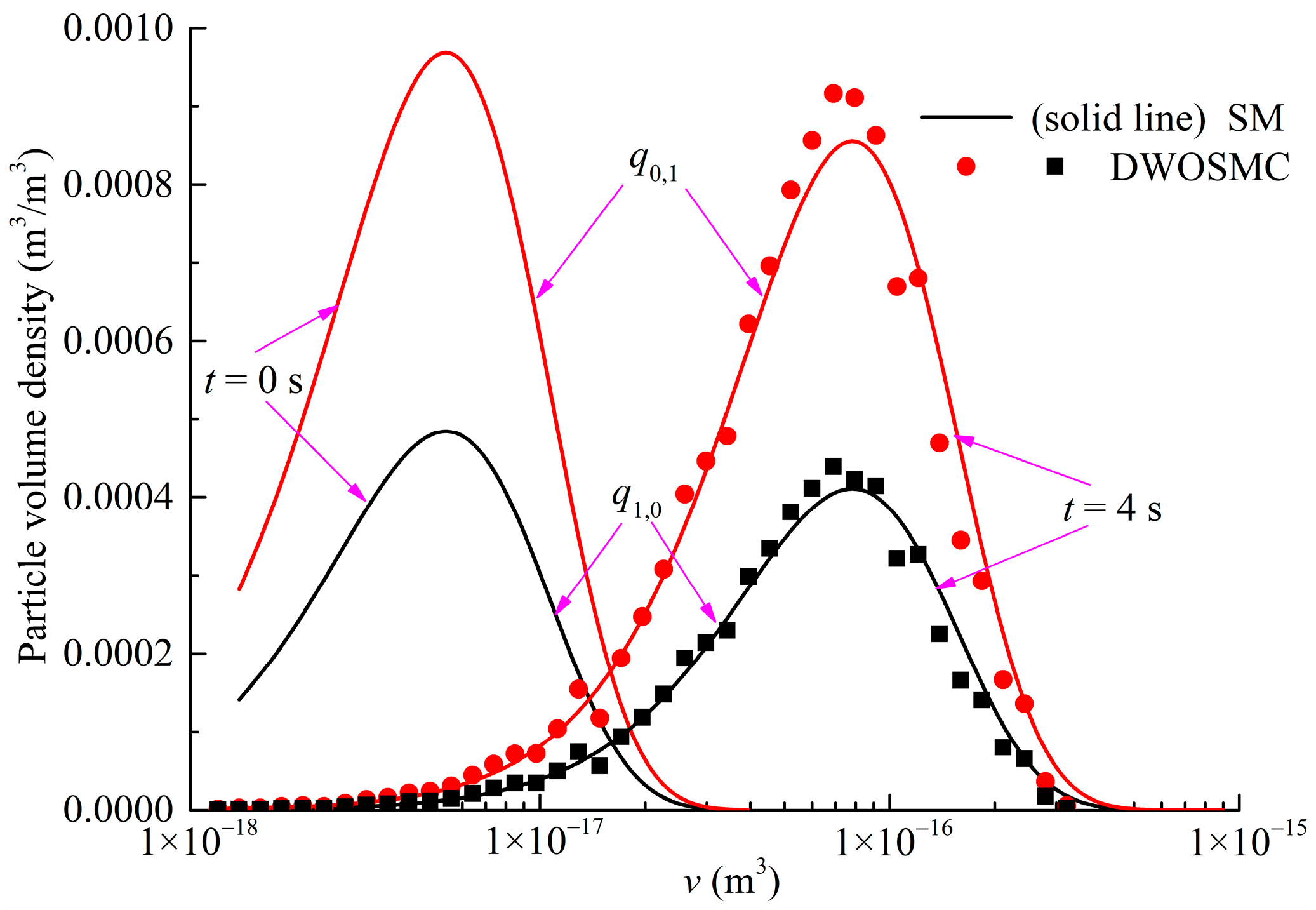
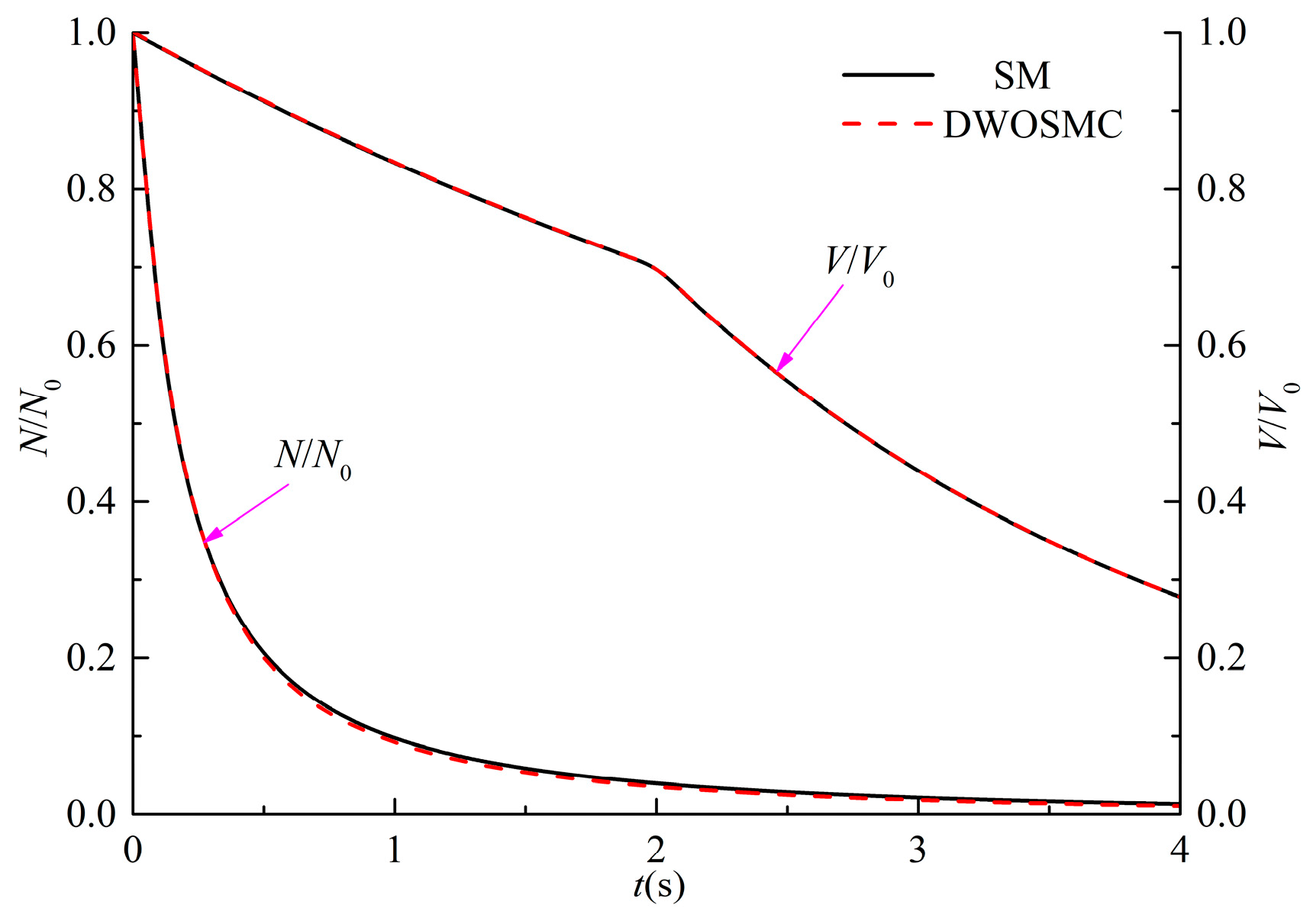

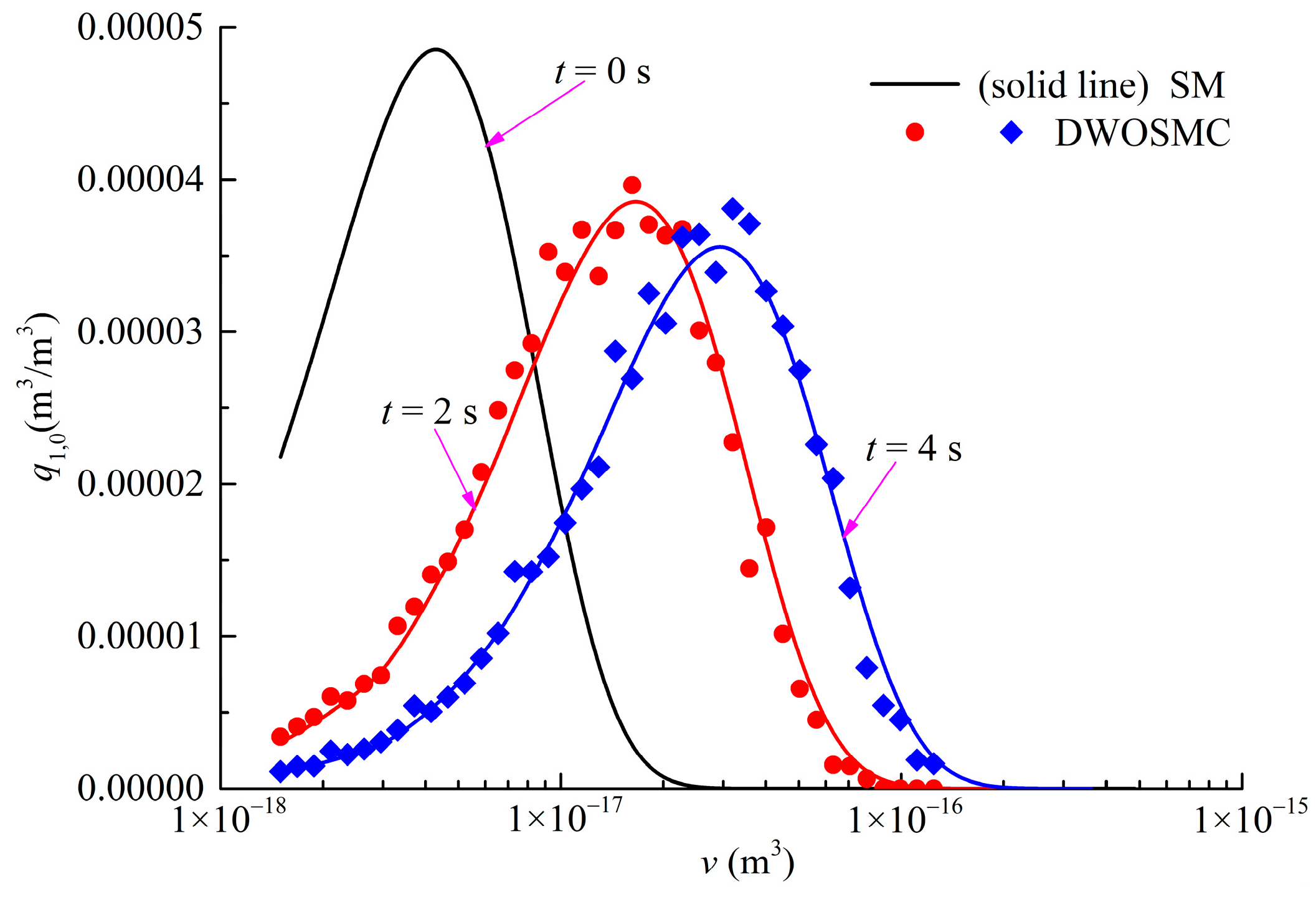
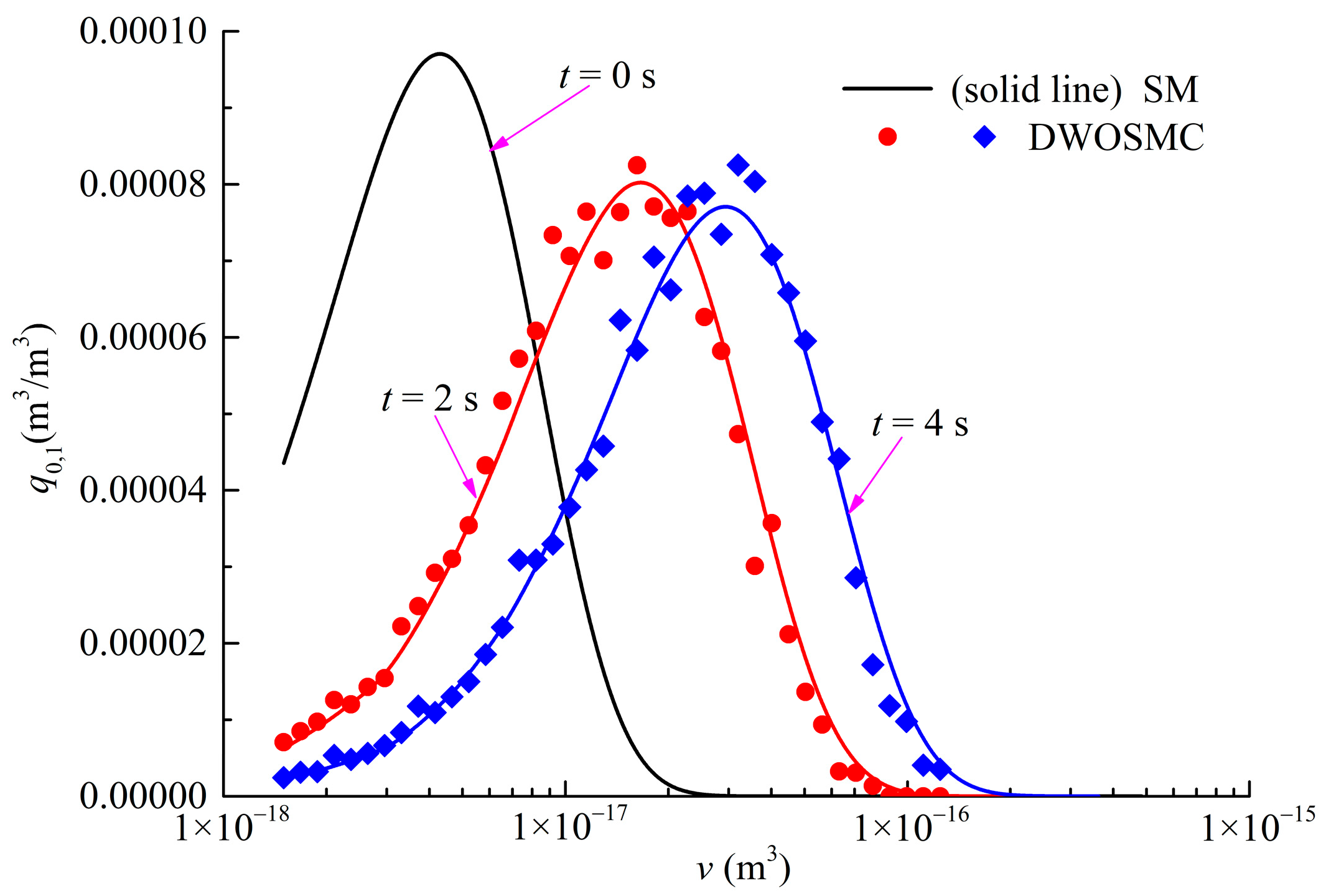
Publisher’s Note: MDPI stays neutral with regard to jurisdictional claims in published maps and institutional affiliations. |
© 2022 by the authors. Licensee MDPI, Basel, Switzerland. This article is an open access article distributed under the terms and conditions of the Creative Commons Attribution (CC BY) license (https://creativecommons.org/licenses/by/4.0/).
Share and Cite
Liu, H.; Shao, J.; Jiang, W.; Liu, X. Numerical Modeling of Droplet Aerosol Coagulation, Condensation/Evaporation and Deposition Processes. Atmosphere 2022, 13, 326. https://doi.org/10.3390/atmos13020326
Liu H, Shao J, Jiang W, Liu X. Numerical Modeling of Droplet Aerosol Coagulation, Condensation/Evaporation and Deposition Processes. Atmosphere. 2022; 13(2):326. https://doi.org/10.3390/atmos13020326
Chicago/Turabian StyleLiu, Hongmei, Jingping Shao, Wei Jiang, and Xuedong Liu. 2022. "Numerical Modeling of Droplet Aerosol Coagulation, Condensation/Evaporation and Deposition Processes" Atmosphere 13, no. 2: 326. https://doi.org/10.3390/atmos13020326
APA StyleLiu, H., Shao, J., Jiang, W., & Liu, X. (2022). Numerical Modeling of Droplet Aerosol Coagulation, Condensation/Evaporation and Deposition Processes. Atmosphere, 13(2), 326. https://doi.org/10.3390/atmos13020326





